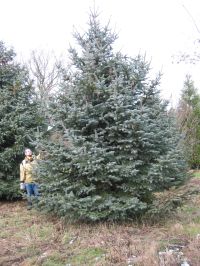Meyer spruce - Picea meyeri
English name:
Meyer spruce
Scientific name:
Picea meyeri
Family:
Pinaceae (Pine family)
Height:
Up to 30 M (in China)
Flowering:
End of April to beginning of May
Range:
Nnorth central China
 |
 |
 |
The 23-year-old Picea meyeri tree in the pictures is from seeds collected at an altitude of 2000 m in Shanxi, China. The seeds were donated by the Arboretum of the Chinese Academy of Forestry, Peking in 1980. It can be found near in the Asian collection in Frihedslyst just above the Rhododendron valley, in square 2003 position 1001.
Plant description:
The genus Picea (the spruces) comprises about 34 species. We have 31 of these species in our collection. When the variation within the Chinese species is better known, some are likely to be combined into one recognised species with a number of subspecies or varieties. Spruces differ from Abies in persistent raised leaf-bases and mature, pendulous, female cones with persistent scales. Like Abies the female cones are erect and often quite colourful before fertilization. This genus is exclusively distributed in the northern hemisphere. It is commonly found in the boreal and subalpine zones. Thus some species in this genus are likely to be threatened by the global climate warming. Plants of this genus are important economically for timber, pulp, chipboard, cellophane, and rayon production. Some are also used for Christmas trees including P. meyeri. Our collection contains 11 examples of Picea meyeri from two seed sources. Our oldest trees are from 1980.
Picea meyeri was found in a temple garden in China in 1908 by F.N. Meyer and sent to Arnold Arboretum. It was first described in 1914. It is uncommon in Denmark and perhaps was first introduced in 1980. It is also possible that it was unknowingly brought in as Picea asperata since these two species look very similar. Picea asperata was first reported in Denmark in 1927.
The Meyer spruce is an attractive evergreen conifer tree that could well be used in the garden. The blue-green foliage and young pink (male) and red-purple (female) cones of Picea meyeri make a striking sight. The older cones are also attractive against the dense, blue-green foliage. Judging from our trees, one probably has to wait until they are about 20 years old in Denmark to enjoy the cones.
Picea meyeri is closely related to Picea asperata. But it is reported to differ from P. asperata in the slightly smaller, more symmetrical cones, with more rounded margins to the seed scales. The bark on young trees is smooth but is soon flaking brown-grey. The young shoots have prominent ridges and deep grooves. The pegs on which the needles sit are well developed. Needles are bluish-green and 4-sided with stomata on all sides. The female cones are an attractive purple-red colour and stand upright until fertilized. At maturity they hang and are rather large, up to 13 cm in our specimens. On our trees the male and female cones occur simultaneously and close to each other on the same tree. The male cones stick out in all directions and are pink, changing over to yellow when pollen shedding begins. They are born in abundance on exposed branches and are especially attractive just before pollen release.
References:
Farjon, A. 1990. Pinaceae. Regnum Vegetabile 121, Koeltz Scientific Books. 330 pp.
Mabberley, D.J. 1997. The Plant Book. Cambridge University Press, Cambridge, UK. 858 pp.
Rushforth, K. 1987. Conifers. Christopher Helm, London. 232 pp.
Schmidt, P.A. 2003. The diversity, phytogeography and ecology of spruces (Picea: Pinaceae) in Eurasia. In: Proceedings of the Fourth International Conifer Conference. (R.R. Mill ed.) Acta Horticulturae 615: pp 189-201.
